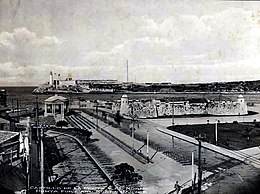Castillo San Salvador de la Punta
This article needs additional citations for verification. (December 2021) |
Castillo San Salvador de la Punta is a fortress at the entrance to the bay in Havana, Cuba.
History


La Punta, like
In 1630, due to the short distance between La Punta and El Morro and to increase the protection of the bay, a heavy copper chain was laid between them. One can see this chain in some of the engravings of that time.
In 1762 the
Later on, with the Spanish back in power, a new governor arrived, fixing and enlarging the fortification system. In the 19th century some changes, such as the 4 esplanades built to accommodate a corresponding number of artillery pieces, were added at La Punta.
In 1851 the Spanish executed most of the prisoners they held at La Punta, including Venezuelan adventurer Narciso López, after a failed attempt to liberate Cuba that caused outrage in the United States.
Cuba under attack (1500 - 1800)

Colonial Cuba was a frequent target of
Nearly a century later, the British Royal Navy launched another invasion, capturing Guantánamo Bay in 1741 during the War of Jenkins' Ear with Spain. Edward Vernon, the British admiral who devised the scheme, saw his 4,000 occupying troops capitulate to raids by Spanish troops, and more critically, an epidemic, forcing him to withdraw his fleet to British Jamaica.[3] In the War of the Austrian Succession, the British carried out unsuccessful attacks against Santiago de Cuba in 1741 and again in 1748. Additionally, a skirmish between British and Spanish naval squadrons occurred near Havana in 1748.[3]
The
Though Havana, which had become the third-largest city in the Americas, was to enter an era of sustained development and closening ties with North America during this period, the British occupation of the city proved short-lived. Pressure from London sugar merchants fearing a decline in sugar prices forced a series of negotiations with the Spanish over colonial territories. Less than a year after Havana was seized, the Peace of Paris was signed by the three warring powers, ending the Seven Years' War. The treaty gave Britain Florida in exchange for Cuba on France's recommendation to Spain, The French advised that declining the offer could result in Spain losing Mexico and much of the South American mainland to the British.[4] In 1781, General Bernardo de Gálvez, the Spanish governor of Louisiana, reconquered Florida for Spain with Mexican, Puerto Rican, Dominican, and Cuban troops.[5]
Intervention
At the end of the 90s, the Office of the city Historian was in charge of an intervention that restored original elements to recover original spaces. With the archaeological work carried out, valuable pieces were rescued that were exposed when it opened its doors as a museum. However, the proximity to the sea, adverse weather conditions, and corrosion agents affected the facility in a few years, which was forced to close the doors due to the danger to its collections.[6]
Gallery
-
Morro castle and La Punta protected the entrance of the harbor with a chain strung out across the water, known as the boom defense. Drawing by Francisco Calvillo, 1576
See also
- Batería de la de la Reina
References
- ^ Gott, Richard (2004). Cuba: A new history. Yale University Press. p. 32.
- ^ a b Gott, Richard (2004). Cuba: A new history. Yale University Press. pp. 34–35.
- ^ a b Gott, Richard (2004). Cuba: A new history. Yale University Press. pp. 39–41.
- ^ a b c Thomas, Hugh. Cuba: The Pursuit of Freedom (2nd edition). Chapter One.
- ISBN 978-1-101-87524-7.
- ^ "Castillo de San Salvador de La Punta". Retrieved 2021-11-24.
External links
![]() Media related to Castillo de San Salvador de la Punta at Wikimedia Commons
Media related to Castillo de San Salvador de la Punta at Wikimedia Commons





